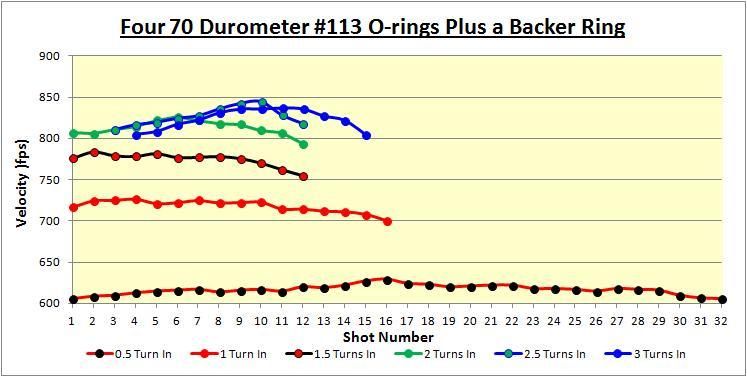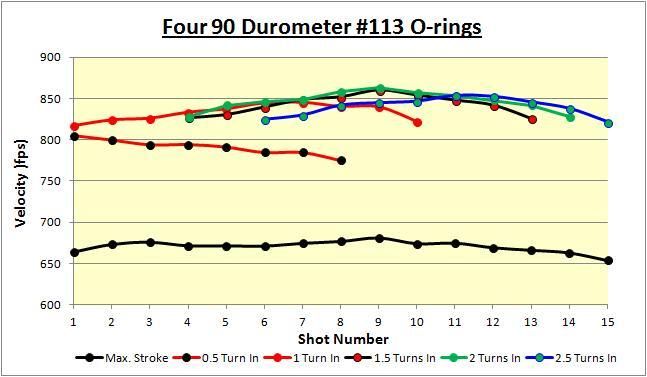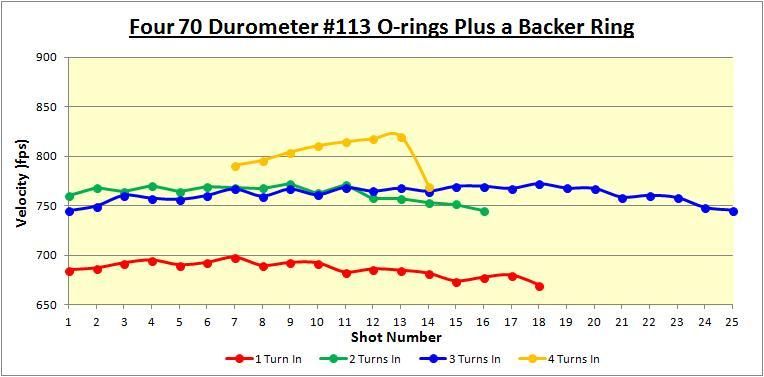One of the most unique ways of tuning the MRod and PRod is the addition of a stack of O-rings to form a buffer between the valve and hammer, called the "bstaley mod" after it's inventor.... It requires a hammer with an adjustable striker extending past the face, such as found in the MRod, PRod, and Challenger.... so the first part of trying this on a Disco is to fit such a hammer.... I chose the one from a Challenger, along with the RVA (rear velocity adjuster aka power adjuster) from a Challenger as well.... You need an adjuster with a hole through the screw so that you can insert a 1/8" allen key to turn the striker to adjust it.... Full CCW provides the maximum hammer stroke before it hits the valve stem, and as you turn the adjuster "in" CW the stroke reduces by 1/28" (0.036") per turn.... Since the end of the stem is fixed (when closed), what actually happens is that the hammer slides back that much, increasing the preload on the hammer spring by the same amount.... However, since the outside face of the hammer is what catches on the sear, the spring length and therefore it's force when cocked stays constant.... These have to some extent a cancelling effect, and the first 3-4 turns adjusting the stroke (in a conventional installation, without the O-rings) seems to have little effect on the velocity.... Once you screw the adjuster out a long ways, drastically reducing the travel, that is no longer the case, and the velocity starts to drop more rapidly.... Here is a photo of the Challenger hammer sitting beside a stock Disco hammer.... Note that I haven't had to cut a notch in the top of the Challenger hammer to clear the 4-48 Disco breech screw because I'm using a 22XX breech with the forward screw location.... In a Disco, the hammer will have to be notched to miss the screw like the Disco hammer is....
Note that the main body of the hammers are the same length, but the striker sticks out 0.080" past the front of the hammer when fully in CCW (as shown).... This means that compared to a Disco hammer, the stroke will be reduced (and the preload increased) by (at least) that amount.... A stock Disco has a hammer travel of 0.58", so when you install a Challenger hammer, that drops to 0.50" (maximum) or less (by 0.036" per turn on the striker).... For lower powered (stock or less) guns that will not be an issue, but it may hamper power tunes, requiring more preload and/or a stiffer hammer spring than would be required if a longer (rather than shorter) stroke was available.... This can be addressed by shortening the valve stem to gain back the lost stroke, and I'll be looking at that much later in this thread as it develops.... There is one #113 O-ring sitting on the front of each hammer.... Note that the Challenger striker, when fully in, comes just flush with the top of a single O-ring (because of the taper on the edge of the hammer).... We will be starting with four of them.... and they are 0.103" thick, so the hammer will make contact with the O-ring stack when the striker (when fully in) is about 0.31" from the back of the valve.... Since a stock Disco valve stem protrudes 0.32" from the back of the valve, that will mean that the valve will only open about 0.010" before the hammer first contacts the O-rings....
At this point, we need a quick review of how unregulated PCPs work.... At the beginning of the shot string, the air pressure is at its highest, and the force holding the valve closed (and closing it once it is open) is at its highest.... Since the hammer strike is (for any given tune) a constant, the valve will get knocked open a tiny amount (the lift), typically about 1/16".... This releases a very small amount of very high pressure air for a very short time (the dwell) to accelerate the pellet.... As the pressure drops, so do the forces resisting the hammer, so the lift increases gradually, and with it the dwell.... The pulse of air gets longer in duration but less in pressure, with the mass of air released remaining relatively constant.... As the pressure continues to drop, the valve opens further and further, and eventually there is not enough pressure to maintain the same mass of air escaping, and the velocity drops, ending the useful shot string, and you have to refill the gun.... At that point, the lift is typically about 1/8", about double what it was when you started.... The velocity in a properly tuned PCP starts out a few percent below the peak, rises, plateaus a bit, and then falls again.... The trick in tuning a PCP is to maintain the velocity within an acceptable Extreme Spread (ES) while getting as many shots as possible.... I usually use 4% as my acceptable ES at 50 yards, narrowing that to only 2% for 100 yards....
I have had a few discussions with bstaley, trying to understand the principles involved, and the basic idea is that as the valve lift increases during the shot string, the hammer, at some point (depending on how you have the stroke adjusted) starts to impact the O-ring buffer.... This reduces the valve lift in the latter part of the shot string.... By adjusting the hammer spring preload and the length of the striker you can govern at what point in the shot string the buffer starts to limit the valve lift, and what the maximum lift at the end of the string is.... Here is a quote from the inventor....
Screwing the striker in CW (when viewed from the rear of the gun) will increase the valve lift before the hammer contacts the buffer.... causing it to become effective later in the shot string.... If you screw the striker in far enough, the hammer will no longer hit the buffer at all.... and the gun will operate "normally", albeit with much reduced hammer stroke.... This is the first principle of the bstaley tune....The main thing to understand is that as the pressure in the tank decreases, more and more of the hammer's energy transfers to the buffer and less to opening the poppet further and for a longer duration. So the stiffness of the buffer will definitely have an effect on the resultant shot string....
AS YOU SCREW IN THE STRIKER CLOCKWISE, IT INCREASES THE VALVE LIFT, INCREASING THE POWER, AND THE BUFFER BECOMES EFFECTIVE LATER IN THE SHOT STRING IF AT ALL.
Start digesting that while I work on my next post....
Bob







 Reply With Quote
Reply With Quote













